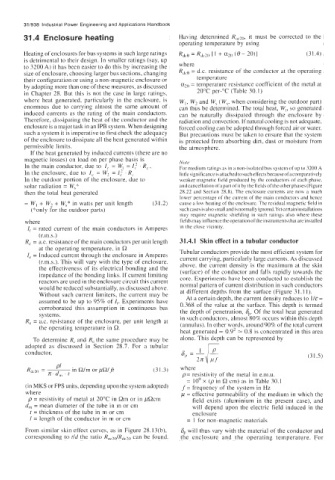Page 993 - Industrial Power Engineering and Applications Handbook
P. 993
31/938 Industrial Power Engineering and Applications Handbook
31.4 Enclosure heating Having determined RaC2", it must be corrected to the
operating temperature by using
Heating of enclosures for bus systems in such large ratings Rdce = Rdc2[) 1 + a20 (0 - 2011 (3 1.4)
is detrimental to their design. In smaller ratings (say, up
to 3200 A) it has been easier to do this by increasing the where
size of enclosure, choosing larger bus sections, changing Rdce = d.c. resistance of the conductor at the operating
their configuration or using a non-magnetic enclosure or temperature
by adopting more than one of these measures, as discussed azo = temperature resistance coefficient of the metal at
in Chapter 28. But this is not the case in large ratings, 20°C per-"C (Table 30.1)
where heat generated, particularly in the enclosure, is W,, W, and W, ( W,, when considering the outdoor part)
enormous due to carrying almost the same amount of can thus be determined. The total heat, W,, so generated
induced currents as the rating of the main conductors. can be naturally dissipated through the enclosure by
Therefore, dissipating the heat of the conductor and the radiation and convection. If natural cooling is not adequate,
enclosure is a major task in an IPB system. When designing forced cooling can be adopted through forced air or water.
such a system it is imperative to first check the adequacy But precautions must be taken to ensure that the system
of the enclosure to dissipate all the heat generated within is protected from absorbing dirt, dust or moisture from
permissible limits. the atmosphere.
If the heat generated by induced currents (there are no
magnetic losses) on load on per phase basis is Note
In the main conductor, due to I, = W, = IF2 . R, , For medium ratings as in a non-isolated bus system of up to 3200 A
In the enclosure, due to I, = Wz If . R, little significance is attached to such effects because of acomparatively
=
In the outdoor portion of the enclosure, due to weaker magnetic field produced by the conductors of each phase.
solar radiation = Ws* andcancellation ofapart ofit by the fieldsoftheotherphases (Figure
then the total heat generated 28.22 and Section 28.8). The enclosure currents are now a much
lower percentage of the current of the main conductors and hence
= W, + W, + Ws* in watts per unit length (31.2) cause a low heating of the enclosure. The residual magnetic field in
(*only for the outdoor parts) suchcases is alsosmall andis normallyignored.Yetcertaininstallations
may require magnetic shielding in such ratings also where these
where fields may influence the operation ofthe instruments that are installed
I, = rated current of the main conductors in Amperes in the close vicinity.
(r.m.s.)
R, = a.c. resistance of the main conductors per unit length 31.4.1 Skin effect in a tubular conductor
at the operating temperature, in R
I, = Induced current through the enclosure in Amperes Tubular conductors provide the most efficient system for
(r.m.s.). This will vary with the type of enclosure, current carrying, particularly large currents. As discussed
above, the current density is the maximum at the skin
the effectiveness of its electrical bonding and the
impedance of the bonding links. If current limiting (surface) of the conductor and falls rapidly towards the
reactors are used in the enclosure circuit this current core. Experiments have been conducted to establish the
normal pattern of current distribution in such conductors
would be reduced substantially, as discussed above. at different depths from the surface (Figure 3 1.11).
Without such current limiters, the current may be At a certain depth, the current density reduces to 1/&=
assumed to be up to 95% of I,. Experiments have 0.368 of the value at the surface. This depth is termed
corroborated this assumption in continuous bus the depth of penetration, SP. Of the total heat generated
systems.
Re = a.c. resistance of the enclosure, per unit length at in such conductors, almost 80% occurs within this depth
the operating temperature in R. (annulus). In other words, around 90% of the total current
heat generated a 0.9' 2- 0.8 is concentrated in this area
To determine R, and R, the same procedure may be alone. This depth can be represented by
adopted as discussed in Section 28.7. For a tubular
conductor,
(31.5)
(3 1.3) where
p= resistivity of the metal in e.m.u.
= 1 O9 x (p in R cm) as in Table 30.1
(in MKS or FPS units, depending upon the system adopted) .f'= frequency of the system in Hz
where p = effective permeability of the medium in which the
p = resistivity of metal at 20°C in Rm or in pRcm field exists (aluminium in the present case), and
d, = mean diameter of the tube in m or cm will depend upon the electric field induced in the
t = thickness of the tube in m or cm enclosure
I = length of the conductor in m or cm = I for non-magnetic materials
From similar skin effect curves, as in Figure 28.13(b), 6, will thus vary with the material of the conductor and
corresponding to tld the ratio Rac20/Rdc20 can be found. the enclosure and the operating temperature. For

